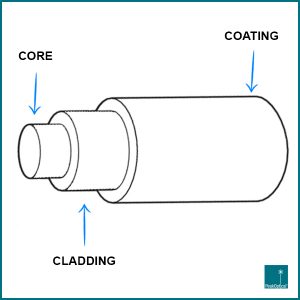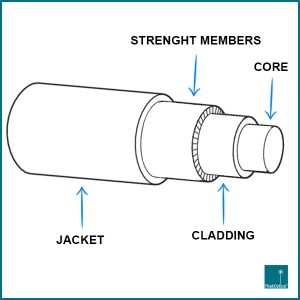Every day that passes by, fiber optics become essential in telecommunications, in industrial data communication, and in wide area networking. The fiber technology assures fast point to point connections, using the basic physics theories of reflection and refraction of light. Light signals are sent from one location to another through thin glass or plastic fibers. The signals can transport both analog or digital information on longer distances, in less time than the classical copper wire.
To get more comfortable with the fiber optic technology and understand how it actually works, it is important to understand the jargon. We have put together a list of terms you should know.
FIRST THINGS FIRST – about the FIBER
 Optic Fiber – Thin, flexible strands made out of glass (or sometimes plastic) that transport information with the help of light signals.
Optic Fiber – Thin, flexible strands made out of glass (or sometimes plastic) that transport information with the help of light signals.
Core – An inner cylinder of glass or plastic that has a high refractive index; The center of the fiber where the light is transmitted.
Cladding – The medium that surrounds the core, with a lower refractive index.
Mode – A self-consistent electromagnetic field that is distributed in the fiber.
Singlemode Fiber – A single glass fiber strand used to transmit a single ray of light. It has a core of 9 microns and goes very long distances at very high speeds. It is also known as uni-mode fiber, mono-mode optical fiber, and single-mode optical waveguide and it is used for telephony and CATV.
Multimode Fiber – It is designed to carry multiple light rays at the same time, still each of them is at a marginally different reflection angle inside the core. It often features a 62.5-µm or 50-µm core diameter.
POF – Plastic Optical Fiber or Polymer Optical Fiber. It is a ~1 mm core multimode fiber that can be used for short, low-speed networks.
FIBER OPTICAL CABLES

Cable – The fiber optic cable is a high-speed data transmission medium. It has numerous optic fibers bundled together with a glass core through which light signals can be transmitted with very little loss of strength.
Jacket – A protective tough outer covering on the cable. Depending on how the cable is going to be used and the operational environment, the jacket will protect against moisture, abrasion, magnetic fields, radiation, and many others.
Strenght members – It is a component added to a jacketed cable. Usually, the strength members are made out of Kevlar Aramid Yarn, but it can also be made out of stiff, flexible fiberglass stem.
SPECIFICATIONS
Bandwidth – The length of a fiber-optic link; The range of signal frequencies within which a fiber optic component will engage.
Attenuation – The reduction in optical power as it passes along a fiber, usually expressed in decibels (dB).
dB – Optical power referenced to an arbitrary zero level.
dBm – Optical power referenced to 1 milliwatt.
Micron (m) – A unit that measures the wavelength of light.
Nanometer (nm) – A unit of measure used to measure the wavelength of light (meaning one one-billionth of a meter).
Scattering – The change of direction of light after striking small particles, that cause loss in optical fibers.
Wavelength – A term for the color of light, usually expressed in nanometers (nm) or microns (m).


